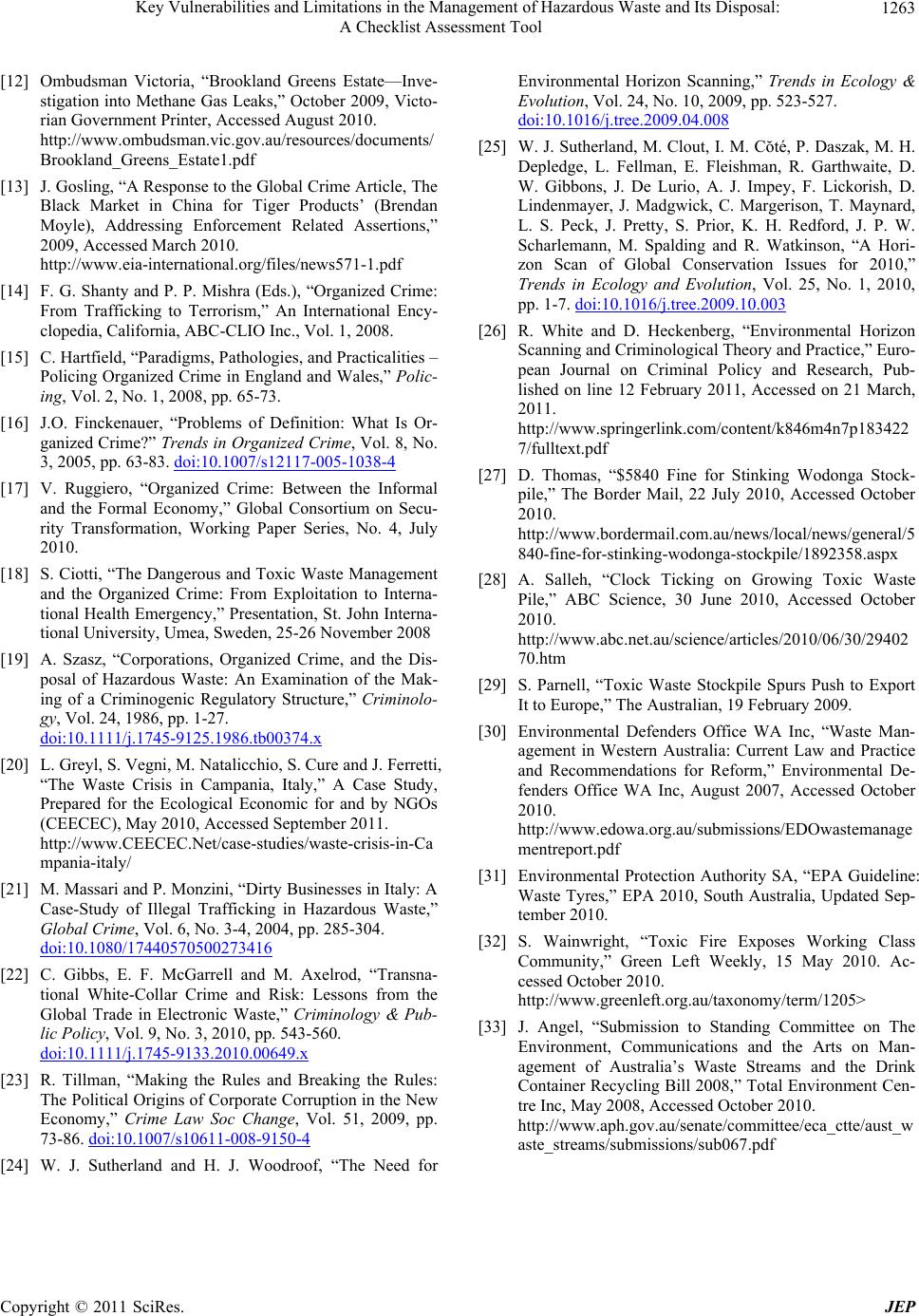
Key Vulnerabilities and Limitations in the Management of Hazardous Waste and Its Disposal: 1263
A Checklist Assessment Tool
[12] Ombudsman Victoria, “Brookland Greens Estate—Inve-
stigation into Methane Gas Leaks,” October 2009, Victo-
rian Government Printer, Accessed August 2010.
http://www.ombudsman.vic.gov.au/resources/documents/
Brookland_Greens_Estate1.pdf
[13] J. Gosling, “A Response to the Global Crime Article, The
Black Market in China for Tiger Products’ (Brendan
Moyle), Addressing Enforcement Related Assertions,”
2009, Accessed March 2010.
http://www.eia-international.org/files/news571-1.pdf
[14] F. G. Shanty and P. P. Mishra (Eds.), “Organized Crime:
From Trafficking to Terrorism,” An International Ency-
clopedia, California, ABC-CLIO Inc., Vol. 1, 2008.
[15] C. Hartfield, “Paradigms, Pathologies, and Practicalities –
Policing Organized Crime in England and Wales,” Polic-
ing, Vol. 2, No. 1, 2008, pp. 65-73.
[16] J.O. Finckenauer, “Problems of Definition: What Is Or-
ganized Crime?” Trends in Organized Crime, Vol. 8, No.
3, 2005, pp. 63-83. doi:10.1007/s12117-005-1038-4
[17] V. Ruggiero, “Organized Crime: Between the Informal
and the Formal Economy,” Global Consortium on Secu-
rity Transformation, Working Paper Series, No. 4, July
2010.
[18] S. Ciotti, “The Dangerous and Toxic Waste Management
and the Organized Crime: From Exploitation to Interna-
tional Health Emergency,” Presentation, St. John Interna-
tional University, Umea, Sweden, 25-26 November 2008
[19] A. Szasz, “Corporations, Organized Crime, and the Dis-
posal of Hazardous Waste: An Examination of the Mak-
ing of a Criminogenic Regulatory Structure,” Criminolo-
gy, Vol. 24, 1986, pp. 1-27.
doi:10.1111/j.1745-9125.1986.tb00374.x
[20] L. Greyl, S. Vegni, M. Natalicchio, S. Cure and J. Ferretti,
“The Waste Crisis in Campania, Italy,” A Case Study,
Prepared for the Ecological Economic for and by NGOs
(CEECEC), May 2010, Accessed September 2011.
http://www.CEECEC.Net/case-studies/waste-crisis-in-Ca
mpania-italy/
[21] M. Massari and P. Monzini, “Dirty Businesses in Italy: A
Case-Study of Illegal Trafficking in Hazardous Waste,”
Global Crime, Vol. 6, No. 3-4, 2004, pp. 285-304.
doi:10.1080/17440570500273416
[22] C. Gibbs, E. F. McGarrell and M. Axelrod, “Transna-
tional White-Collar Crime and Risk: Lessons from the
Global Trade in Electronic Waste,” Criminology & Pub-
lic Policy, Vol. 9, No. 3, 2010, pp. 543-560.
doi:10.1111/j.1745-9133.2010.00649.x
[23] R. Tillman, “Making the Rules and Breaking the Rules:
The Political Origins of Corporate Corruption in the New
Economy,” Crime Law Soc Change, Vol. 51, 2009, pp.
73-86. doi:10.1007/s10611-008-9150-4
[24] W. J. Sutherland and H. J. Woodroof, “The Need for
Environmental Horizon Scanning,” Trends in Ecology &
Evolution, Vol. 24, No. 10, 2009, pp. 523-527.
doi:10.1016/j.tree.2009.04.008
[25] W. J. Sutherland, M. Clout, I. M. Cŏté, P. Daszak, M. H.
Depledge, L. Fellman, E. Fleishman, R. Garthwaite, D.
W. Gibbons, J. De Lurio, A. J. Impey, F. Lickorish, D.
Lindenmayer, J. Madgwick, C. Margerison, T. Maynard,
L. S. Peck, J. Pretty, S. Prior, K. H. Redford, J. P. W.
Scharlemann, M. Spalding and R. Watkinson, “A Hori-
zon Scan of Global Conservation Issues for 2010,”
Trends in Ecology and Evolution, Vol. 25, No. 1, 2010,
pp. 1-7. doi:10.1016/j.tree.2009.10.003
[26] R. White and D. Heckenberg, “Environmental Horizon
Scanning and Criminological Theory and Practice,” Euro-
pean Journal on Criminal Policy and Research, Pub-
lished on line 12 February 2011, Accessed on 21 March,
2011.
http://www.springerlink.com/content/k846m4n7p183422
7/fulltext.pdf
[27] D. Thomas, “$5840 Fine for Stinking Wodonga Stock-
pile,” The Border Mail, 22 July 2010, Accessed October
2010.
http://www.bordermail.com.au/news/local/news/general/5
840-fine-for-stinking-wodonga-stockpile/1892358.aspx
[28] A. Salleh, “Clock Ticking on Growing Toxic Waste
Pile,” ABC Science, 30 June 2010, Accessed October
2010.
http://www.abc.net.au/science/articles/2010/06/30/29402
70.htm
[29] S. Parnell, “Toxic Waste Stockpile Spurs Push to Export
It to Europe,” The Australian, 19 February 2009.
[30] Environmental Defenders Office WA Inc, “Waste Man-
agement in Western Australia: Current Law and Practice
and Recommendations for Reform,” Environmental De-
fenders Office WA Inc, August 2007, Accessed October
2010.
http://www.edowa.org.au/submissions/EDOwastemanage
mentreport.pdf
[31] Environmental Protection Authority SA, “EPA Guideline:
Waste Tyres,” EPA 2010, South Australia, Updated Sep-
tember 2010.
[32] S. Wainwright, “Toxic Fire Exposes Working Class
Community,” Green Left Weekly, 15 May 2010. Ac-
cessed October 2010.
http://www.greenleft.org.au/taxonomy/term/1205>
[33] J. Angel, “Submission to Standing Committee on The
Environment, Communications and the Arts on Man-
agement of Australia’s Waste Streams and the Drink
Container Recycling Bill 2008,” Total Environment Cen-
tre Inc, May 2008, Accessed October 2010.
http://www.aph.gov.au/senate/committee/eca_ctte/aust_w
aste_streams/submissions/sub067.pdf
Copyright © 2011 SciRes. JEP